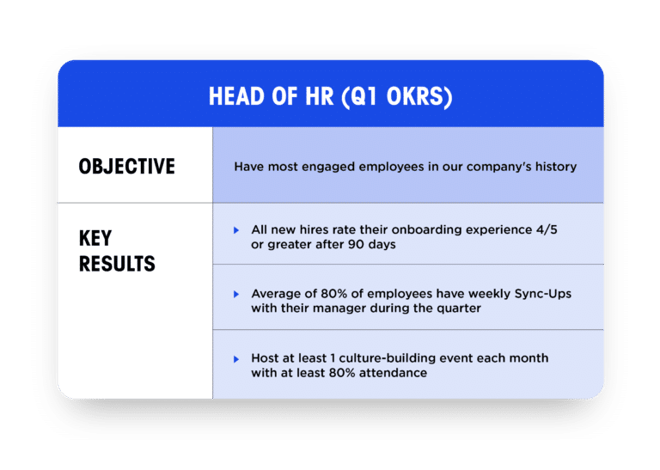What do Amazon, Google, and Intel all have in common? Goal setting. That's right, despite their differences, each of these industry titans uses the objectives and key results (OKR) goaling method to fast track growth in increasingly saturated markets.
OKRs are used to align high-level business targets to department, team, and individual outcomes. Ambitious by nature, this approach to setting goals at work offers a repeatable, scalable process that can positively impact a business' bottom line through innovation and accountability.
Ready to start incorporating OKRs into your organization? Read on to learn:
History of OKRs
Andy Grove, often referred to as the "Father of OKRs," first developed the goal-setting method while working as the CEO of Intel. Modeled after Peter Drucker's "Management by Objectives" method from the 1950s, OKRs would go on to inspire venture capitalist and fellow Intel employee John Doerr.
Fascinated by the results he saw at Intel, Doerr took OKRs with him to Google, where the top-down approach to goal setting gained worldwide popularity.In the present day, John Doerr continues to assert the value of OKRs to companies across the globe. He even went as far as to develop a formula to aid companies in establishing their goals.
John Doerr Formula: I will [Objective] as measured by [Key Results]
What are OKRs?
As we mentioned earlier, OKRs are broken down into two parts: Objectives and Key Results.
Objectives are high-level goals that define where a business wants to go. Objectives should be qualitative, inspiring, and describe a future state. For example: "Be a market leader in our industry" or "Have the most engaged employees in our company's history."
Key results are not actions you need to take to achieve your goal. Instead, think of them as outcomes that your organization needs to achieve in order to reach your objective. Key results should be quantifiable or measurable in some way. A good rule of thumb is to have 3-5 key results per objective.
Here's an example of how to write an OKR:

Objective: Have most engaged employees in our company's history
Key results:
- All new hires rate their onboarding experience 4/5 or greater after 90 days
- Average of 80% of employees have weekly 1-on-1 Sync-Ups with their manager during the quarter
- Host at least 1 culture-building event each month with at least 80% attendance
Remember: OKRs are stretch goals, to set and adjust frequently. Generally, hitting 60-70% of an OKR is considered a success. To use this goaling approach, try rolling out new OKRs at the end of the quarter. Then, track progress over a three-month period to assess whether a goal still serves the greater company vision.
And because OKRs are inherently difficult to achieve, it's worth setting proper expectations with your team the first time you create goals together.
Tips for setting OKRs
Use recognition to fill the gap
How do you let team members who need to hit 100% of a goal know they’re doing well with the OKR method? It’s simple — you recognize them. Business OKRs thrive in an environment where recognition is given and received, whether from an executive or another coworker. In fact, studies show a whopping 70% of employees say that motivation and morale would improve “massively” if managers said thank you more often.
Remember: OKRs impact the bottom line
In a study, retail giant Sears asked 20,000 employees to use OKRs to write their goals. The result? The group who used OKRs saw an increase in average sales per hour from $14.44 per hour to $15.67, or an average increase of 8.5%.
Years of research supports the theory that goal-setting works. In fact, Dr. Gail Matthews, an expert in the field of goal-setting, found that people are 42% more likely to achieve their goals if they simply write them down on a regular basis.
Align individual, team, and company goals with OKRs
One of the most useful attributes of OKRs is that they help align a company’s goals with team and individual goals.
- Individual goals, established through quarterly Check-Ins, define what the person is working on
- Team goals define priorities for the team
- Company OKRs are big picture, a top-level focus for the entire company
Why is alignment important? First, as we argue in our Employee Experience Manifesto, alignment has a profound effect on an employee's experience with your company. But as far as your bottom line? Gallup research shows even a 10% improvement in employees' connection with the mission or purpose of their organization results in an 8.1% decrease in turnover, and a 4.4% increase in profitability.
OKRs vs. SMART goals: Which is better?
Individual SMART goals and business OKRs are two of the most used goal-setting methods in modern workplaces. People love pitting them against each other — "SMART goals or OKRs?" they ask. Here's a truth bomb: This is a nonsense false dichotomy. Each approach serves its own purpose — SMART goals and OKRs work better in conjunction with one another.
We'll break it down.
SMART goals are tactical and best used to set achievable, attainable goals (which is what the A stands for!) where the success rate depends on the completion of a goal. On the other hand, OKRs are “out there” company stretch goals that push us to innovate.
A thriving organization uses a blend of SMART goals, OKRs, and other goal-setting techniques to establish goals, but a truly successful business tracks the impact of its goals.



